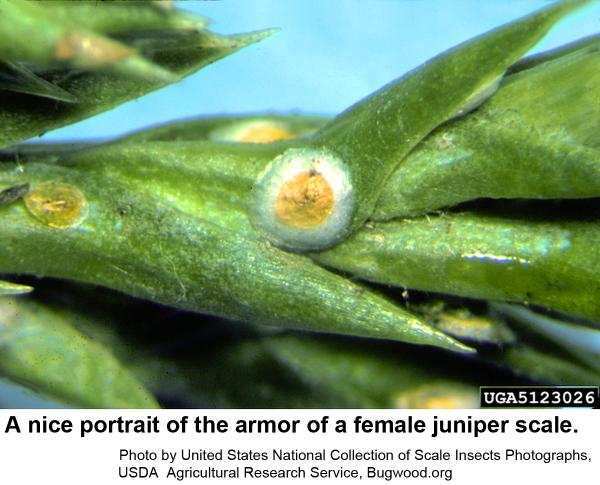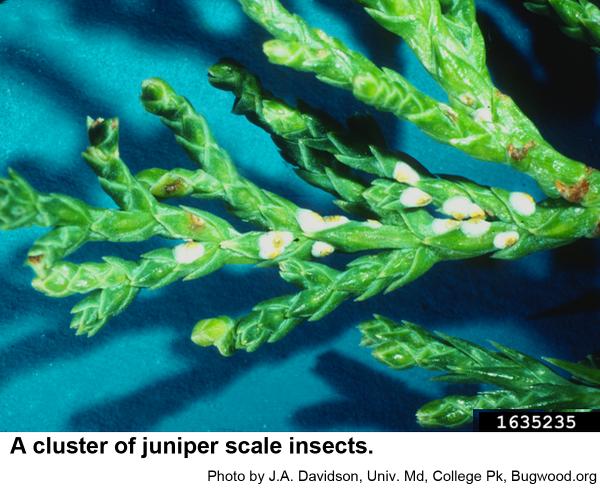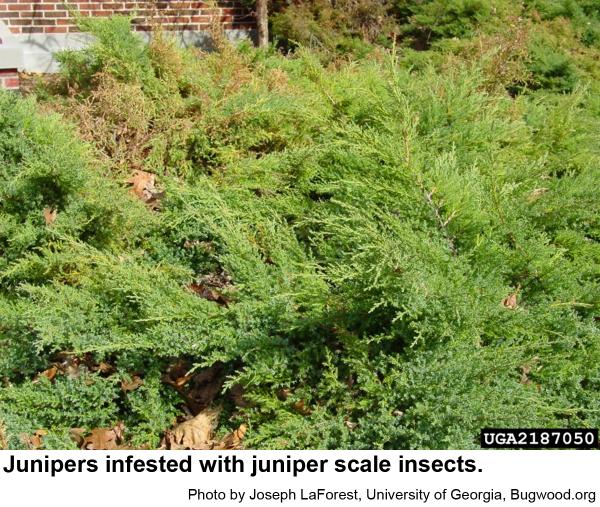Description and Biology
The juniper scale insect, Carulaspis juniperi, is a very small (up to 3/32 inch wide) armored scale insect. The armor of females is circular to oval and is white and parchmentlike. In the center are light yellow cast skins of the earlier female nymph stages so the armor more or less resembles a tiny fried egg. The armor of the male scales is oblong, white, and almost 1/16 inch long. At one end is the pale yellow cast skin of the crawler stage. Adult males are tiny, gnat-like insects with four eyes and a tiny waxy tail filament. Crawlers resemble mobile pollen and are flat with six legs and antennae. Because they are so small juniper scales are easily overlooked. This species overwinters as mature fertilized females. Around May, females lay an average of 40 eggs inside their armor and then die. Crawlers hatch about two weeks later. Crawlers emerge to find a suitable place to feed on the host plant or they may be blown onto nearby hosts or carried there on the feet of birds. Once a female crawler inserts its thread-like mouthparts, it does not move again. Females go through three growth stages, and males go through five. Adult males emerge, mate with females, and then soon die (males have no mouth parts!). We have one generation per year in North Carolina.
Host Plants
Juniper scales infest eastern red cedar and many other junipers as well as Calocedrus decurrens, Chamaecyparis, Cryptomeria, and cypress including Leyland cypress. Infested plants often have dead or stunted twigs, uneven growth, and unthrifty foliage.
Residential Recommendations
Dustywing insects feed on eggs and other life stages of juniper scales, and lady beetles are often associated with juniper scale. Four species of tiny wasps parasitize this pest as well. A horticultural oil applied during May and June should greatly reduce these scales although it will be helpful to apply these oils whenever juniper scales are discovered and again two weeks later. Safari, a systemic insecticide, should give adequate control as well.
Other Resources
- Armored Scale Identification and Management on Ornamental Plants. Frank, S. 2010. Entomology Insect Notes, NC State Extension Publications.
-
Florida Armored Scale Insects. Dekle, G. W. 1965. Arthropods of Florida and Neighboring Land Areas, Vol 3. 265 pp.
- Juniper Scale. Skvarla, M. J. 2002. Insect Advice from Extension, PennState College of Agr. Sciences, Entomology.
- Juniper Scale. Larson, J. L. 2021 (revised). ENTFACT-429. Entomology, University of Kentucky College of Agriculture.
- Extension Plant Pathology Publications and Factsheets
- Horticultural Science Publications
- North Carolina Agricultural Chemicals Manual
For assistance with a specific problem, contact your local Cooperative Extension center.
This Factsheet has not been peer reviewed.
Publication date: Feb. 21, 2019
Reviewed/Revised: Dec. 20, 2023
Recommendations for the use of agricultural chemicals are included in this publication as a convenience to the reader. The use of brand names and any mention or listing of commercial products or services in this publication does not imply endorsement by NC State University or N.C. A&T State University nor discrimination against similar products or services not mentioned. Individuals who use agricultural chemicals are responsible for ensuring that the intended use complies with current regulations and conforms to the product label. Be sure to obtain current information about usage regulations and examine a current product label before applying any chemical. For assistance, contact your local N.C. Cooperative Extension county center.
N.C. Cooperative Extension prohibits discrimination and harassment regardless of age, color, disability, family and marital status, gender identity, national origin, political beliefs, race, religion, sex (including pregnancy), sexual orientation and veteran status.




